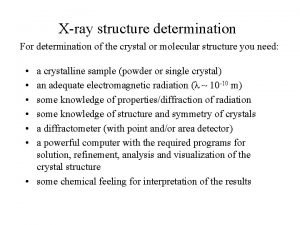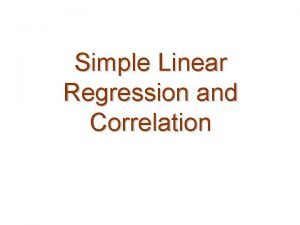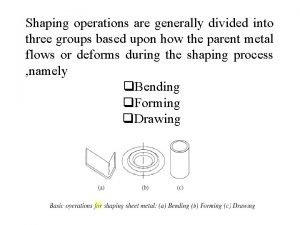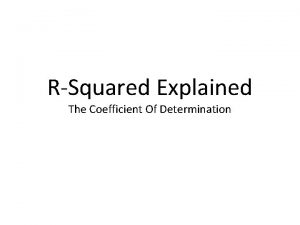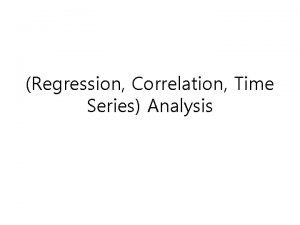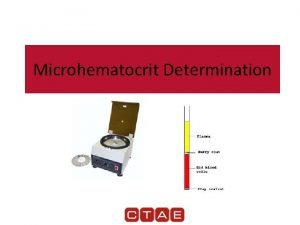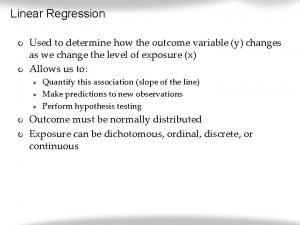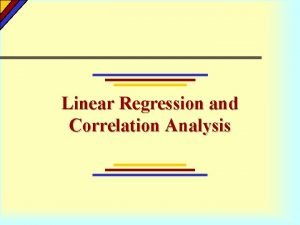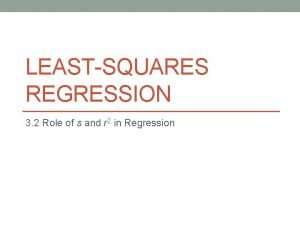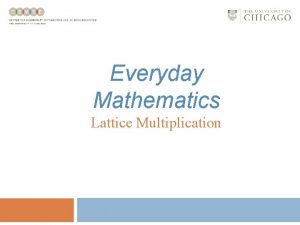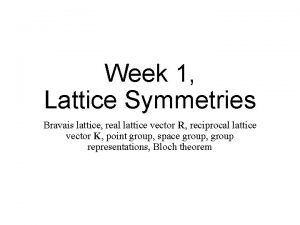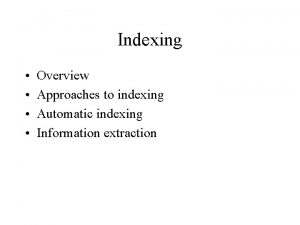indexing lattice parameters space group determination Indexing powder








































- Slides: 40

indexing | lattice parameters

space group determination Indexing - powder diffraction is NOT method #1 to solve crystal structures! - indexing of an unkown diffraction pattern - goal: solution of the crystal structure!!! - problem: unknown phase(s) - measured data are 1 D projection of 3 D-lattices (objects) only lengths, but no directions of reciprocal lattice vectors measureable (in single crystal diffraction, also the direction can be determined) Finde das kleinste Parallelepiped im reziproken Raum, welches die beobachtete Serie an Bragg-Peaks beschreibt! (konsistent mit kristallographischen Konventionen) - each reciprocal lattice point corresponds to a set of lattice planes in direct space each Bragg peak must be assigned by a set of Laue indices (Miller indices)

space group determination indexing

space group determination indexing - relies heavily on the accurate determination of dhkl (unit cell parameters) - problems: - random errors - low-symmetric unit cells - peak overlap - instrumental abberations - etc.

space group determination indexing with known unit cell - listing of all possible/observable hkl indices calculation of interplanar distances allocation of all hkl triples refine unit cell parameters if necessary

space group determination indexing with known unit cell

space group determination indexing with known unit cell goal of indexing (and refinement of unit cell parameters) - minimisation - unit with highest symmetry unit cell with smallest volume smallest number of hkl indices smallest difference between measured and calculated Bragg positions

space group determination indexing with unknown unit cell - mostly trial and error - 6 unit cell parameters - hkl allocation without knownledge of the unit cell iterative process until all peaks have a useful index (brut force) - = reconstruction of the directions of reciprocal lattice vectors from their lenghts

space group determination indexing with unknown unit cell - solution is possible, since crystallographic rules exist (contraints)

space group determination indexing with unknown unit cell - solution is possible, since crystallographic rules exist (contraints) - main constraints - peaks at low angles have simplest indices (h, k, l = -2 … 2) - extinct reflections for small diffraction angles - high absolute accuracy of angular positions (minimise: z displacement, zero error) - avoid sample contamination - the lower the symmetry, the higher the complexity of the problem

11

space group determination indexing with unknown unit cell - use a couple of peaks at low angles as basis set - permutation of h, k, l starting at the basis set and allocation of hkl to the peaks - trial and error algorithms (for high symmetry: kub … orth) TREOR - size of basis set = number of independent unit cell parameters DICVOL - allocate up to 30 additional peaks starting with the trial lattice (basis set) - the larger the basis set, the higher the probability of a positive solution - initial crystal system should have the highest symmetry - usually multiple solutions are created - zone search algorithms (for low symmetry: mon, tri) ITO - search in 1 D (z. B. h 00, h 10, 0 k 0, …) - continue with search of 2 D zones (z. B. hk 0, h 1 l, 0 kl, …) - combination: create a 3 D lattice - try to index the whole diffraction pattern with proposed 3 D lattice - result is in most cases a primitive cell, which needs to be reduced to one of the 14 Bravais lattices

space group determination TREOR http: //www. ccp 14. ac. uk/ccp 14/ccp 14 -by-program/treor/ - uses trial and error algorithm - uses some restrictions regarding permutations (increase of computational speed)

determination of lattice parameters - errors in the lattice parameters directly result from errors in the determination of the Bragg angles (peak positions) - determination of lattice parameters at high angles - refinement with least squares fitting methods

determination of lattice parameters line position = position of the maximum 2 B = 2 (I = max) 15

determination of lattice parameters line position = position of the maximum of the fitted function 16

determination of lattice parameters line position = position of the maximum of the fitted function 17

determination of lattice parameters determination of line position – choice of the profile function - profile function contains three convoluted contributions: - instrumental profile - wavelength dispersion of the source - physical profile of the sample m … overlap of m lines k … Bragg peak y … Peak function b … background

determination of lattice parameters determination of the line position – choice of the profile function - Gauss: - Lorentz: Caglioti equation

determination of lattice parameters determination of line position – choice of profile function - pseudo-Voigt: - Pearson VII:

determination of lattice parameters determination of line position– choice of profile function

determination of lattice parameters determination of line position – choice of profile function Pearson VII

determination of lattice parameters determination of line position – data refinement

determination of lattice parameters determination of line position – errors in peak position - peak positions directly reflect the reciprocal lattice (interplanar distance = length of reciprocal lattice vectors) - these may differ from their ideal positions through: zero error axial divergence (reduced by Soller, usually negelcted, peak asymmetry) h … size of the sample K 1, 2 … collimator constants flat specimen (violates focussing, usually neglected) a … divergence (eq. ) K 3 … constant sample transparency (penetration of the beam in thick samples, especially for weak scatterers) m … lin. absorption coefficient sample displacement (error in position of the sampel) z … distance to focussing circle

determination of lattice parameters detrmination of line position – data refinement

determination of lattice parameters cubic structures 26

determination of lattice parameters cubic structures 2 d (d 1)²/d²(h²+k²+ℓ²) hkℓ a cos cot 27. 51 3. 239 1. 000 3 111 5. 61026 3. 967 31. 87 2. 806 1. 333 3. 998 4 200 5. 61174 3. 368 45. 66 1. 985 2. 663 7. 988 8 220 5. 61463 2. 189 54. 12 1. 693 3. 660 10. 979 11 311 5. 61572 1. 743 56. 74 1. 621 3. 992 11. 976 12 222 5. 61600 1. 630 66. 53 1. 404 5. 321 15. 962 16 400 5. 61687 1. 274 73. 41 1. 289 6. 317 18. 952 19 331 5. 61736 1. 075 75. 65 1. 256 6. 649 19. 948 20 420 5. 61750 1. 017 84. 40 1. 147 7. 978 23. 934 24 422 5. 61799 0. 817 90. 86 1. 081 8. 974 26. 923 27 511 5. 61830 0. 691 27 333 101. 70 0. 993 10. 635 31. 904 32 440 5. 61874 0. 514 108. 39 0. 950 11. 631 34. 892 35 531 5. 61896 0. 422 110. 67 0. 937 11. 963 35. 888 36 600 5. 61903 0. 393 36 442 120. 21 0. 888 13. 291 39. 872 40 620 5. 61930 0. 287 128. 01 0. 857 14. 286 42. 859 43 533 5. 61948 0. 214 130. 80 0. 847 14. 618 43. 855 44 622 5. 61953 0. 191 143. 47 0. 811 15. 946 47. 838 48 444 5. 61975 0. 103 27

determination of lattice parameters cubic structures a 0 Cohen Wagner plot (cubic lattice) Bragg-Brentano diffractometer, cubic lattice 28

determination of lattice parameters cubic structures Nullpunktverschiebung Cohen Wagner plot (cubic lattice) 29

determination of lattice parameters non-cubic lattice - linear least squares fitting - system of linear equations contains 2 , and lattice parameters and the linear correlation between them - A(n, m) with n > m has a vector of solution x for n unknowns, being the best solution for all n: overdetermined system least squares refinement - best solutions result from the calculation of all partial differentiations, equalled to 0 - solution is obtained from:

determination of lattice parameters non-cubic lattice - problem of determination of the lattice parameters: same formulation in the reciprocal lattice non-linear in a, b, c, a, b, g

determination of lattice parameters non-cubic lattice - reformulation for the problem of lattice parameter determination:

determination of lattice parameters non-cubic lattice - reformulation for the problem of lattice parameter determination: = results of the refinement -> allows to extract lattice parameters

determination of lattice parameters non-cubic lattice - reformulation for the problem of lattice parameter determination: - taking systematic errors into account sample dislacement: zero error: trigonometry: for small x, one can approximate: both are non-linear

determination of lattice parameters non-cubic lattice - reformulation for the problem of lattice parameter determination: - taking systematic errors into account = results of the refinement -> allows to extract lattice parameters

determination of lattice parameters non-cubic lattice - error calculation - use of weights w for individual peak positions - peak positions of lines with high intensity can be determined more precisely - dhkl determeined at high 2 are more accurate than those determined at low 2 - etc.

determination of lattice parameters non-cubic lattice - error calculation - use of weights w for individual peak positions - calculation of the standard deviation: n … number of equations (elements in y) m … number of unknown parameters

determination of lattice parameters systematic errors zero error parameter correlation displacement

determination of lattice parameters systematic errors spikes

determination of lattice parameters
 Pre coordinate indexing system
Pre coordinate indexing system Manual indexing vs automatic indexing
Manual indexing vs automatic indexing Lattice adalah
Lattice adalah Different types of powders in pharmacy
Different types of powders in pharmacy Disadvantages of powders
Disadvantages of powders Powder characterization in powder metallurgy
Powder characterization in powder metallurgy Example of divided powder
Example of divided powder Group discussion parameters
Group discussion parameters Grains
Grains Unscented trajectory chapter 5
Unscented trajectory chapter 5 Space junk the space age began
Space junk the space age began Camera space to world space
Camera space to world space Unscented trajectory chapter 5
Unscented trajectory chapter 5 World space computer
World space computer Pbcn space group
Pbcn space group X-ray structure determination
X-ray structure determination Linear regression riddle a answer key
Linear regression riddle a answer key Blank determination example
Blank determination example Y chromosome traits
Y chromosome traits Brainpop sex
Brainpop sex What is sex linkage in biology
What is sex linkage in biology Self advocacy worksheets
Self advocacy worksheets How to compute sample size
How to compute sample size Shipping point determination
Shipping point determination Shipping point determination sap
Shipping point determination sap R squared interpretation
R squared interpretation Requirement determination
Requirement determination Correlation stufy
Correlation stufy Determination and description of material quality
Determination and description of material quality Quantitative determination of proteins
Quantitative determination of proteins Determination in sanskrit
Determination in sanskrit Price determination under monopolistic competition
Price determination under monopolistic competition Serious tone
Serious tone Grit vs determination
Grit vs determination Microhematocrit reading
Microhematocrit reading Coefficient of determination interpretation example
Coefficient of determination interpretation example Linear regression example
Linear regression example Coefficient of determination interpretation example
Coefficient of determination interpretation example Gravimetric determination of phosphorus in plant food
Gravimetric determination of phosphorus in plant food Differentiation vs determination
Differentiation vs determination Manifestation determination meeting agenda
Manifestation determination meeting agenda















